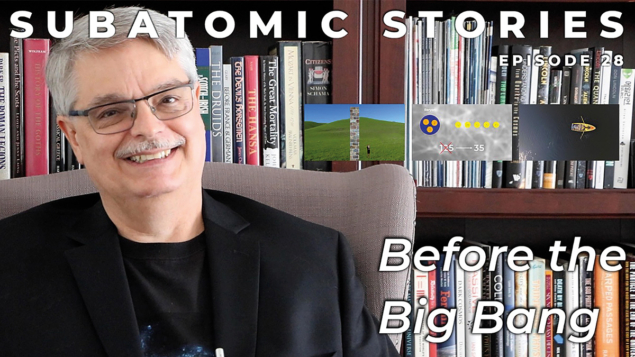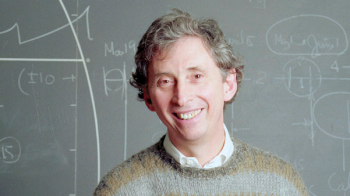Appearing in robes, alongside pets and sliced into parallel dimensions, Don Lincoln is a well-known face of Fermilab’s outreach. He tells the Courier how he manages to combine physics and outreach, and why more physicists should take up the challenge.

What got you into physics?
I have always been interested in what one might call existential questions: those that were originally theological or philosophical, but are now science, such as “why are things the way they are?” When I was young, for me it was a toss-up: do I go into particle physics or cosmology? At the time, experimental cosmology was less developed, so it made sense to go towards particle physics.
What has been your research focus?
When I was a graduate student in college, I was intrigued by the idea of quantum mechanical spin. I didn’t understand spin and I still don’t. It’s a perplexing and non-intuitive concept. It turned out the university I went to was working on it. When I got there, however, I ended up doing a fixed-target jet-photoproduction experiment. My thesis experiment was small, but it was a wonderful training ground because I was able to do everything. I built the experiment, wrote the data acquisition and all of the analysis software. Then I got back on track with the big questions, so colliders with the highest energies were the way to go. Back then it was the Tevatron and I joined DØ. When the LHC came online it was an opportunity to transition to CMS.
Why and when did you decide to get into communication?
It has to do with my family background. Many physicists come from families where one or both parents are already from the field. But I come from an academically impoverished, blue-collar background, so I had no direct mentors for physics. However, I was able to read popular books from the generation before me, by figures such as Carl Sagan, Isaac Asimov or George Gamow. They guided me into science. I’m essentially paying that back. I feel it’s sort of my duty because I have some skill at it and because I expect that there is some young person in some small town who is in a similar position as I was in, who doesn’t know that they want to be a scientist. And, frankly, I enjoy it. I am also worried about the antiscience sentiment I see in society, from the antivaccine movement to climate-change denial to 5G radiation fears. If scientists do not speak up, the antiscience voices are the only ones that will be heard. And if public policy is based on these false narratives, the damage to society can be severe.
Scientists doing outreach create goodwill, which can lead to better funding for research-focused scientists
How did you start doing YouTube videos?
I had got to a point in my career where I was fairly established, and I could credibly think of other things. When you’re young, you are urged to focus entirely on research, because if you don’t, it could harm your research career. I had already been writing for Fermilab Today and I kept suggesting doing videos, as YouTube was becoming a thing. After a couple of years one of the videographers said, “You know, Don, you’re actually pretty good at explaining this stuff. We should do a video.” My first video came out a year before the Higgs discovery, in July 2011. It was on the Higgs boson. When the video came out, a few of the bigger science outlets picked it up and during the build-up to the Higgs excitement it got more and more views. By now it has more than three million clicks, which for a science channel is a lot. We do serious science in our videos, but there is also some light-heartedness in them.
Do you try to make the videos funny?
This has more to do with me not taking anything seriously. I have found that irreverent humour can be disarming. People like to be entertained when they are learning. For example, one video was about “What was the real origin of mass?” Most people think that the Higgs boson is giving mass, but it’s really QCD. It’s the energy stored inside nucleons. In any event, in this video I start out with a joke about going into a Catholic church. The Higgs boson tries to say “I’m losing my faith,” and the priest replies: “You can’t leave the church. Without you how can we have mass?” For a lot of YouTube channels, viewership is not just about the material. It’s about the viewer liking the presenter. I’d say people who like our channel appreciate the combination of reliable science facts, but also subscribe for the humour. If a viewer doesn’t like a guy who does terrible dad jokes, they just go to another channel.
During the Covid-19 pandemic your videos switched to “Subatomic stories”. How do they differ?
Most of my videos are done in a studio on green screen so that we can put visuals in the background, but that was not possible during the lockdown. We then did a set up in my living room. I had an old DSLR camera and a recorder, and would record the video and the audio, then send the files to my videographer, Ian Krass, who does all the magic. Our usual videos don’t have a real story arc; they are just a series of topics. With “Subatomic stories” we began with a plan. I organised it as a sort of self-contained course, beginning with basic things, like the Standard Model, weak force, strong force, etc. Towards the end, we introduced more diverse, current research topics and a few esoteric theoretical ideas. Later, after Subatomic stories, I continued to film in my basement in a green-screen studio I built. We’ve returned to the Fermilab studio, but the basement one is waiting should the need arise.
You are quite the public face of Fermilab. How does this relationship work?
It’s working wonderfully. I have no complaints. I can’t say that was always true in the past, because, when you’re young, you’re advised to focus on your research; it was like that for me. At the time there was some hostility towards science communicators. If you did outreach, you weren’t really considered a serious scientist, and that’s still true to a degree, although it is getting better. For me, it got to the point where people were just used to me doing it, and they tolerated it. As long as it didn’t bother my research, I could do this on my time. Some people bowl, some people knit, some people hike. I made videos. As I started becoming more successful, the laboratory started embracing the effort and even encouraged me to spend some of my work day on it. I was glad because in the same way that we encourage certain scientists to specialise in AI or computational skills or detector skills, I think that we as a field need to cultivate and encourage those scientists who are good at communicating our work. The bottom line is that I am very happy with the lab. I would like to see other laboratories encourage at least a small subset of scientists, those who are enthusiastic about outreach, to give them the time and the resources to do it, because there’s a huge payoff.

What are your favourite and least favourite things about doing outreach?
I think I’m making an impact. For instance, I’ve had graduate students or even postdocs ask me to autograph a book saying, “I went into physics because I read this book.” Occasionally I’m recognised in public, but the viewership numbers tell the story. If a video does poorly, it will get 50,000 viewers. And a good video, or maybe just a lucky one, can get millions. The message is getting out. As for the least favourite part, lately it is coming up with ideas. I’ve covered nearly every (hot) topic, so now I am thinking of revisiting early topics in a new way.
What would be your message to physicists who don’t have time or see the need for science communication?
Let’s start with the second type, who don’t see the value of it. I would like to remind them that essentially, in any country, if you want to do research, your funding comes from taxpayers. They work hard for their money and they certainly don’t want to pay taxes, so if you want to ask them to support this thing that you’re interested in, you need to convince them that it’s important and interesting. For those who don’t have time, I’m empathetic. Depending on your supervisor, doing science communication can harm a young career. However, in that case I think that the community should at least support a small group of people who do outreach. If nothing else, the scientists doing outreach create goodwill, which can lead to better funding for research-focused scientists.
Where do you see particle physics headed and the role of outreach?
The problem is that the Standard Model works well, but not perfectly. Consequently, we need to look for anomalies both at the LHC and with other precision experiments. I imagine that the next decade will resemble what we are doing now. I think it would be of very high value if we could spend some money on thinking about how to make stronger magnets and advanced acceleration technologies, because that’s the only way we’re going to get a very large increase in energy. The scientists know what to do. We are developing the techniques and technologies needed to move forward. On the communication side, we just need to remind the public that the questions particle physicists and cosmologists are trying to answer are timeless. They’re the questions many children ask. It’s a fascinating universe out there and a good science story can rekindle anyone’s sense of child-like wonder.








